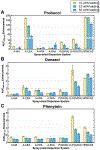Automation and data-driven design of polymer therapeutics
- PMID: 33242537
- PMCID: PMC8127395
- DOI: 10.1016/j.addr.2020.11.009
Automation and data-driven design of polymer therapeutics
Abstract
Polymers are uniquely suited for drug delivery and biomaterial applications due to tunable structural parameters such as length, composition, architecture, and valency. To facilitate designs, researchers may explore combinatorial libraries in a high throughput fashion to correlate structure to function. However, traditional polymerization reactions including controlled living radical polymerization (CLRP) and ring-opening polymerization (ROP) require inert reaction conditions and extensive expertise to implement. With the advent of air-tolerance and automation, several polymerization techniques are now compatible with well plates and can be carried out at the benchtop, making high throughput synthesis and high throughput screening (HTS) possible. To avoid HTS pitfalls often described as "fishing expeditions," it is crucial to employ intelligent and big data approaches to maximize experimental efficiency. This is where the disruptive technologies of machine learning (ML) and artificial intelligence (AI) will likely play a role. In fact, ML and AI are already impacting small molecule drug discovery and showing signs of emerging in drug delivery. In this review, we present state-of-the-art research in drug delivery, gene delivery, antimicrobial polymers, and bioactive polymers alongside data-driven developments in drug design and organic synthesis. From this insight, important lessons are revealed for the polymer therapeutics community including the value of a closed loop design-build-test-learn workflow. This is an exciting time as researchers will gain the ability to fully explore the polymer structural landscape and establish quantitative structure-property relationships (QSPRs) with biological significance.
Keywords: Artificial intelligence; Automation; Drug delivery; Gene delivery; High throughput screening; Machine learning; Polymer chemistry.
Copyright © 2020 Elsevier B.V. All rights reserved.
Figures














Similar articles
-
Artificial Intelligence for Autonomous Molecular Design: A Perspective.Molecules. 2021 Nov 9;26(22):6761. doi: 10.3390/molecules26226761. Molecules. 2021. PMID: 34833853 Free PMC article. Review.
-
Automation of Controlled/Living Radical Polymerization.Adv Intell Syst. 2020 Feb;2(2):1900126. doi: 10.1002/aisy.201900126. Epub 2019 Dec 3. Adv Intell Syst. 2020. PMID: 35586369 Free PMC article.
-
Combinatorial approaches in post-polymerization modification for rational development of therapeutic delivery systems.Acta Biomater. 2018 Jun;73:21-37. doi: 10.1016/j.actbio.2018.04.010. Epub 2018 Apr 12. Acta Biomater. 2018. PMID: 29654990 Free PMC article. Review.
-
Frontiers in nonviral delivery of small molecule and genetic drugs, driven by polymer chemistry and machine learning for materials informatics.Chem Commun (Camb). 2023 Nov 30;59(96):14197-14209. doi: 10.1039/d3cc04705a. Chem Commun (Camb). 2023. PMID: 37955165 Review.
-
Novel trends in high-throughput screening.Curr Opin Pharmacol. 2009 Oct;9(5):580-8. doi: 10.1016/j.coph.2009.08.004. Epub 2009 Sep 21. Curr Opin Pharmacol. 2009. PMID: 19775937 Review.
Cited by
-
Engineering poly- and micelleplexes for nucleic acid delivery - A reflection on their endosomal escape.J Control Release. 2023 Jan;353:518-534. doi: 10.1016/j.jconrel.2022.12.008. Epub 2022 Dec 9. J Control Release. 2023. PMID: 36496051 Free PMC article. Review.
-
Technological Innovations in Photochemistry for Organic Synthesis: Flow Chemistry, High-Throughput Experimentation, Scale-up, and Photoelectrochemistry.Chem Rev. 2022 Jan 26;122(2):2752-2906. doi: 10.1021/acs.chemrev.1c00332. Epub 2021 Aug 10. Chem Rev. 2022. PMID: 34375082 Free PMC article. Review.
-
Machine learning guided structure function predictions enable in silico nanoparticle screening for polymeric gene delivery.Acta Biomater. 2022 Dec;154:349-358. doi: 10.1016/j.actbio.2022.09.072. Epub 2022 Oct 4. Acta Biomater. 2022. PMID: 36206976 Free PMC article.
-
Data-Driven Methods for Accelerating Polymer Design.ACS Polym Au. 2021 Dec 28;2(1):8-26. doi: 10.1021/acspolymersau.1c00035. eCollection 2022 Feb 9. ACS Polym Au. 2021. PMID: 36855746 Free PMC article. Review.
-
Trends of Artificial Intelligence (AI) Use in Drug Targets, Discovery and Development: Current Status and Future Perspectives.Curr Drug Targets. 2025;26(4):221-242. doi: 10.2174/0113894501322734241008163304. Curr Drug Targets. 2025. PMID: 39473198 Review.
References
-
- Rudra A, Li J, Shakur R, Bhagchandani S, Langer R, Trends in Therapeutic Conjugates: Bench to Clinic, Bioconjug. Chem, 31 (2020) 462–473. - PubMed
-
- Du AW, Stenzel MH, Drug Carriers for the Delivery of Therapeutic Peptides, Biomacromolecules, 15 (2014) 1097–1114. - PubMed
-
- Russo D, de Angelis A, Garvey CJ, Wurm FR, Appavou MS, Prevost S, Effect of Polymer Chain Density on Protein-Polymer Conjugate Conformation, Biomacromolecules, 20 (2019) 1944–1955. - PubMed
-
- Ekladious I, Colson YL, Grinstaff MW, Polymer-drug conjugate therapeutics: advances, insights and prospects, Nat. Rev. Drug Discov, 18 (2019) 273–294. - PubMed
Publication types
MeSH terms
Substances
Grants and funding
LinkOut - more resources
Full Text Sources
Other Literature Sources

